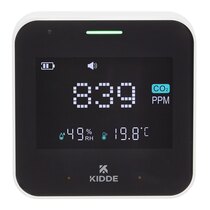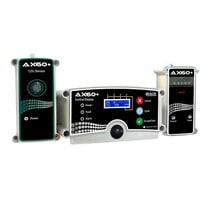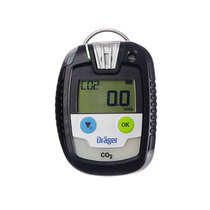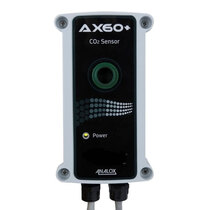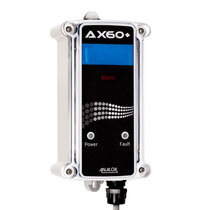-
Contact
Sales & Customer Service
0800 612 6537 support@safelincs.co.uk Live ChatDelivery Enquiries
0800 077 6149 - Resources
Fire & Safety Solutions
CALL OUR TEAM NOW 0800 612 6537
Lines open today 8am - 6pm
FREE Delivery
on marked products
Live Chat - Online
Instant help & Advice
Trade Discounts
and exclusive pricing
0% Credit Available
Open an account now
5 Star Customer Feedback
Air Quality Monitors & Carbon Dioxide (CO2) Detectors
Air quality monitors detect contaminants and undesirable gases in the air such as CO2, Volatile Organic Compounds (VOCs) such as paint fumes, and unauthorised smoking or vaping. They can be ideal in home or office environments to remind occupants to ventilate and let in fresh air, reducing levels of CO2 (carbon dioxide) known to impair concentration, as well as help prevent the accumulation of fine particulates and airborne viruses. In more commercial and industrial settings, such as pub cellars, breweries, laboratories, medical facilities, and greenhouses, advanced calibrated CO2 monitors can warn of a life-threatening build up of this deadly gas.
Were you looking for Carbon Monoxide (CO) alarms?
Mains-Powered Carbon Dioxide (CO2) Air Quality Monitor with "Traffic Light" & Voice Alerts - Kidde KCO2M10
Carbon dioxide is a large contributor to poor air quality indoors, causing tiredness and reducing concentration. Know when to ventilate your room with clear 'traffic light' LEDs & voice alerts.
- Mains powered carbon dioxide monitor with 12hr backup battery
- Digital display of CO2 level, temperature, and humidity
- Clear traffic light indicators to show air quality
- Voice alerts over 1500ppm, which can be muted
Hispec Mains Powered SMART Vape Detector
- Real-time monitoring via TUYA app
- No internal sounder – silent remote alarm via app notification
- The vape detector is designed to cover an area of 30³ (approx. LxWxH 5 x 3 x 2m)
- Device will send a notification if the detector has been tampered with or has been powered off
Analox Ax60+ Fixed CO2 Monitor, Sensor and Alarm Kit
Professional, reliable carbon dioxide detection, monitoring & warning. Ideal for pub cellars, schools, labs, greenhouses, and more.
- Relays can activate fans and gas shut-off valves
- Easy to install Quick Connect fittings – no difficult wiring
- Expandable system, install additional sensors and alarms at any time
- CE marked, UL certified, and EH40 compliant
Dräger PAC 8000 Personal CO2 Detector
Keep personnel working in hazardous environments safe at every moment with wearable gas detection from the world's leading manufacturer.
- Unlimited lifetime – serviceable battery and sensor
- Detects carbon dioxide levels from 0% to 5% by volume
- Superior water and dust ingress protection – IP68
- Light, long-lasting, accurate, reliable life-saving
Analox Ax60+ CO2 Sensor
Expand your Analox gas monitor system with the Ax60+ CO2 sensor. Add up to 4 in any system, easy to retrofit, with Quick Connect for simple installation.
- Up to 4 sensors in a single system
- Can be used alongside Ax60+ oxygen sensors
- Increased coverage for even better life-saving performance
- CE marked, UL certified, and EH40 compliant
Analox Ax60+ Alarm Unit with Blue Strobe
Increase the alarm coverage of your Analox gas monitor system with the Ax60+ alarm and strobe unit. Over 80dB sound output and 100cd blue strobe light.
- Up to 4 alarms per sensor (max 8 in one system)
- Can be used with Ax60+ CO2 and oxygen sensors
- Increased alarm coverage for even wider hazard warning
- CE marked and UL certified
What are air quality monitors?
Air quality monitors are devices designed to measure various contaminants in the air within indoor environments. Their primary purpose is to ensure that the air within a space is safe, clean, and comfortable to breathe. Depending on the exact capabilities of each model, these devices can monitor various parameters such as temperature, humidity, carbon dioxide (CO2), particulate matter (PM2.5 and PM10), and volatile organic compounds (VOCs).
There are several key benefits to using indoor air quality monitors. Firstly, they provide real-time data about the air quality – some with a screen showing the actual reading, others with a simple "traffic light" colour system – enabling individuals to take immediate action if pollutant levels rise above the recommended limits. This could involve opening doors and windows to ventilate the room, adjusting the temperature and humidity levels, or identifying and eliminating the source of pollutants. Secondly, these monitors can help to prevent health issues associated with poor air quality, such as allergies, asthma, and other respiratory conditions. Lastly, they can contribute to overall well-being and productivity, as good air quality has been linked to better sleep, improved concentration, and lower stress levels. Thus, indoor air quality monitors play a crucial role in maintaining a healthy indoor environment.
Some may also be "smart" devices which can connect to a mobile app, allowing users to monitor or be alerted to air quality issues at all times. Some smart air quality monitors may integrate with other smart home systems, potentially allowing the automated control of heating, vents, or air purifiers depending on their readings.
Carbon Dioxide (CO2) Detectors
Safelincs offers a range of carefully selected CO2 monitors, detectors and alarms from leading and trusted manufacturers. These include portable, wearable detectors and fixed multi-sensor alarm systems for environments with potentially toxic carbon dioxide concentrations. Standalone monitors are used for measuring lower levels of CO2 in homes and low-hazard enclosed spaces as this is an excellent indicator of basic air quality. Installing a simple CO2 monitor is fast becoming the de facto method of ensuring good ventilation in offices and school classrooms to reduce transmission of airborne viruses and bacteria.
What is the difference between Monitor, Detector, and Alarm?
These terms are often seen as being interchangeable and there are no hard and fast rules within the smoke, fire and gas detection industry on their use. Where carbon dioxide gas is the hazard, the terms used are even more variable. The most important thing is to understand the features you need and what the product offers, whatever name is used.
Alarm - The term "Alarm" generally refers to a loud audible noise to ensure that persons are made aware of a hazard that is potentially life-threatening. Where non-toxic CO2 levels are measured in order to gauge air quality and feature an audible alert, "Alarm" is often used by some but might be better though of as "Alert", "Warning" or "Notification". As for an Alarm device, this is quite consistently used to mean one which features both a Detector and a Sounder as a single unit. The best example of a safety-critical CO2 alarm would be a personal, portable device worn by operatives moving through environments where high levels of carbon dioxide could be found.
Monitor - A Monitor is typically a device which constantly samples the air for the purposes of measuring air quality rather than warning of an immediate risk to life. Levels of CO2 are displayed to a good degree of accuracy (even down to 0.1%) and may be shown along with temperature and humidity. Monitors may or may not feature an audible warning sounder but most will show some kind of text or symbolic warning, possibly with accompanying colour indicators.
Detector - This term is the most widely used and also the most confusing. Person-worn devices as described above are commonly called "Personal CO2 Detectors" though the purpose is to Alarm the user to danger. However, in a fixed system like those used in breweries, cellars and laboratories, a Detector is simply the unit that analyses the levels of CO2 present; the alarm function is performed by a separate Sounder, and several Detectors and Sounders can be used in one system connected to a Control and Display Unit.
Is carbon dioxide dangerous?
At high a enough concentration carbon dioxide is lethal. Such levels are most often present only in confined spaces and resulting from a human-made process such as those used in manufacturing, chemical production, agriculture, or the beverage industry. CO2 is also a naturally occurring gas at around 0.04% of the atmosphere (400ppm). Carbon dioxide is odourless and colourless so if levels rise they cannot be detected by humans until the effects of overexposure become noticeable.
Because CO2 is heavier than air it will sink in confined spaces and displace oxygen. This process, rather than poisoning by carbon dioxide, is the cause of so many deaths in agriculture. Such tragedies can be avoided by good health and safety practices and provisions, the latter of which includes equipment for measuring CO2 levels and alerting operatives at set trigger levels within their workplace.
At lower concentrations below around 5000ppm, CO2 is generally not harmful but will produce noticeable health effects as levels rise above normal. Symptoms range from mild drowsiness & feelings of a lack of fresh air to headaches, loss of concentration & attention, sleepiness, and nausea. Stale air is also a perfect environment for airborne transmission of diseases, so monitoring CO2 levels is a great way to stay alert and healthy.




















